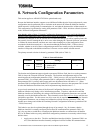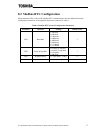
G7 ASD Multi-Protocol Communication Option and PG Feedback Option Manual
21
9.2 Profibus Interface Connection
Table 8 provides DB-9 connector pin descriptions for Profibus connector CN3.
Table 8: Pin description for Profibus connector CN3
Pin
Number
Function In/Out
1 No connection -
2 No connection -
3 Profibus network “B” (positive) data line In/out
4 RTS signal – direction control for fiber optic network interface Out
5
DGND – power supply ground internally connected to the interface
board’s isolated ground
-
6
VP – power supply +5v internally connected to the interface board’s
isolated P5.
-
7 No connection -
8 Profibus network “A” (negative) data line In/out
9
RTS signal ground reference – internally connected to the interface
board’s isolated ground
-
To connect to the Multicom interface, complete the following steps:
1. Connect the Profibus network cable to the DB9 connector marked “CN3” on the G7 Multicom
Option. Refer to the Profibus Specification for detailed network wiring guidelines. Ensure that the
Profibus network cable is tightly screwed onto the DB9 connector, and route the cable such that it is
located well away from any drive input power or motor wiring. Also take care to route the cable
away from any sharp edges or positions where it may be pinched.
2. Grounding is of particular importance for reliable, stable operation. Communication system
characteristics may vary from system to system, depending on the system environment and
grounding method used. The metallic housing of the DB9 connector (CN3) will be regarded as the
“Shield GND” of the Multicom interface. The “Shield GND” should be connected to the shield of
the Profibus network cable through the Profibus connector. To ground the network cable shield,
therefore, connect a wire to the “Shield GND”, and then connect the other end of the wire to an
appropriate ground. For specific requirements regarding protective grounding and the Profibus
network, refer to the Profibus Standard (EN 50 170, part 1).
9.3 Unit Addressing
The Profibus node (slave) address is set via parameter F802 (inverter number parameter). Although
parameter F802 has an adjustment range from 0-255, only 0-126 is an allowable addressing selection for
the Profibus network. Therefore, if parameter F802 is set to 127 through 255, the Multicom interface
will default to an address of 126.


















